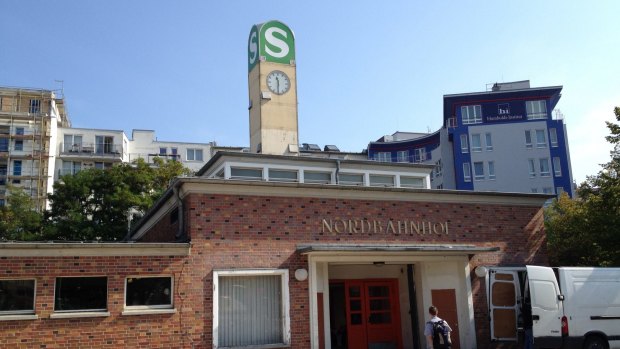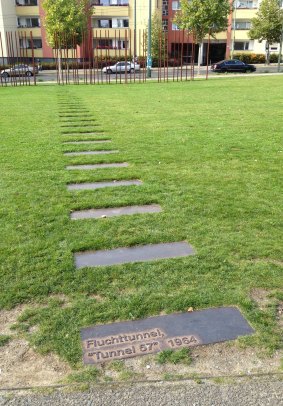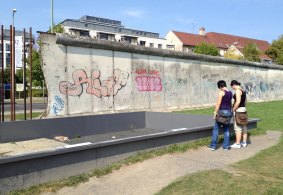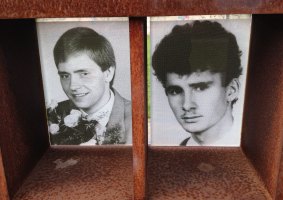This was published 8 years ago
Ghost train stations of Berlin: The last wall
A wander down Berlin's Bernauer Strasse conjures up a time of tunnels, risky crossings and powder-keg tension between East and West.
By Tim Richards

Nordbahnhof S-Bahn station is a former Cold War "ghost station".Credit: Tim Richards
If I'd been standing in this S-Bahn station three decades ago, I'd be in a spot of bother.
Nowadays Nordbahnhof is just like any other Berlin station. Opened in 1936, it's an unremarkable brick structure with below-ground platforms decorated with bland cream tiles.
During the Cold War, however, Nordbahnhof was a so-called "ghost station" in East Berlin. Located in a no-man's-land behind the Berlin Wall, in a strip patrolled by border guards, it was inaccessible to passengers for 30 years.

A memorial traces Tunnel 57 at the Berlin Wall.Credit: Tim Richards
Strangely though, trains still ran through the station, connecting destinations in West Berlin. Passengers would peer out at the dimly lit platforms as their trains barrelled through this snippet of the East, blocked off and neglected.
Nowadays Nordbahnhof is back in operation, and travellers happily troop in and out of its tunnels in this section of the Mitte district. But the past is not forgotten, as its concourse hosts an exhibition of the various ghost stations of the Cold War era.
It's a fascinating topic. As the displays explain, these ghost stations were eerie places, often dotted with East German guards who could be glimpsed on the platforms as West Berlin trains ran through. Sometimes they were invisible, peering at the trains from hidden observation points.

Remnants of the Berlin Wall. Credit: Tim Richards
The Nordbahnhof exhibition is a mere entrée to the official Berlin Wall Memorial, which stretches north-east from the station along Bernauer Strasse, the street that divided East and West.
As the border fell on the east (actually south-east) side of the road, this street was a potent symbol of the divided city: shop-fronts and residential buildings of West Berlin along one side, the cold grey concrete face of the Wall along the other.
The memorial grew from a monument built in 1998 to the memory of those who lost their lives trying to cross the border, and was later extended to a 1.4-kilometre zone divided into four themed sections.

Tributes to those who didn't survive the crossing.Credit: Tim Richards
Though parts of the Wall have been retained elsewhere in the city, this is the only stretch with all the elements of the Cold War border: the famous outer wall, the fortifications and patrol strip beyond it, and a secondary wall beyond that.
It's a remarkably atmospheric place to take a stroll. Along Bernauer Strasse, a line of rust-coloured poles initially indicate the wall's line, before merging with a surviving original section.
On a broad grass area behind it are numerous interpretive items. Pillars explain the fate of individuals who died attempting the crossing, as do markers embedded in the ground. Other displays depict the security measures in place along the Wall, including alarms and watchtowers.
Across the street, the memorial's visitor centre plays two short films about the wall and East Germany's wider border fortifications. They're both excellent, leaving me marvelling at the amount of money, time and manpower involved in corralling the state's own people.
Back at the wall, I find the sad memorial containing photographs of all who died in the crossing attempt.
Further along, the wall became entangled with a church cemetery. In the 1990s the church attempted to reclaim the land by building its own brick wall and gate, which now stand adrift among the remnant communist-era slabs.
Another poignant structure is a chapel built on the site of an 1894 church, which was incorporated into the wall as an observation post before being demolished in 1985. Its twisted metal cross was recovered, and stands on display near its strikingly modern circular successor.
I'm intrigued by trails of stone slabs, staged across the grass. These trace escape tunnels through which East Berliners dug their way to freedom. Tunnel 57 was one of the most successful – several people made their way undetected through it in 1964.
I've reached another former ghost station, Bernauer Strasse U-Bahn, so I decide to end my Cold War stroll here.
At the nearby Ost-West Café, enterprising Turkish-German proprietors lure patrons with displays of East Berlin memorabilia and an inventively contrived menu.
As I wait for my Ost-West Sandwich (triangular halves filled with chicken and spiked with watchtowers of olives on sticks), I think about the dark history of the wall, and the way it divided people both physically and psychologically.
Then I remember two boys I saw earlier, bouncing a soccer ball off its sinister concrete surface as they walked along, chatting happily on a sunny Berlin day.
A fragment of the Wall remains, never to be forgotten; but life in its shadow goes on.
Tim Richards travelled courtesy of Railbookers Australia.
THE FACTS
FLY
Etihad (etihad.com) and partners fly to Berlin via Abu Dhabi, from $2200 return.
Alternatively, Railbookers (railbookers.com.au) can arrange a rail itinerary to Berlin from various European cities.
STAY
InterCityHotel Berlin Hauptbahnhof, Katharina Paulus Strasse 5, Berlin, intercityhotel.com.
Hotel Adlon Kempinski, Unter den Linden 77, Berlin, kempinski.com.
SEE
Berlin Wall Memorial, Bernauer Strasse, Berlin, berliner-mauer-gedenkstaette.de.
Sign up for the Traveller Deals newsletter
Get exclusive travel deals delivered straight to your inbox. Sign up now.